wheel MITSUBISHI ECLIPSE 1990 User Guide
[x] Cancel search | Manufacturer: MITSUBISHI, Model Year: 1990, Model line: ECLIPSE, Model: MITSUBISHI ECLIPSE 1990Pages: 391, PDF Size: 15.27 MB
Page 35 of 391
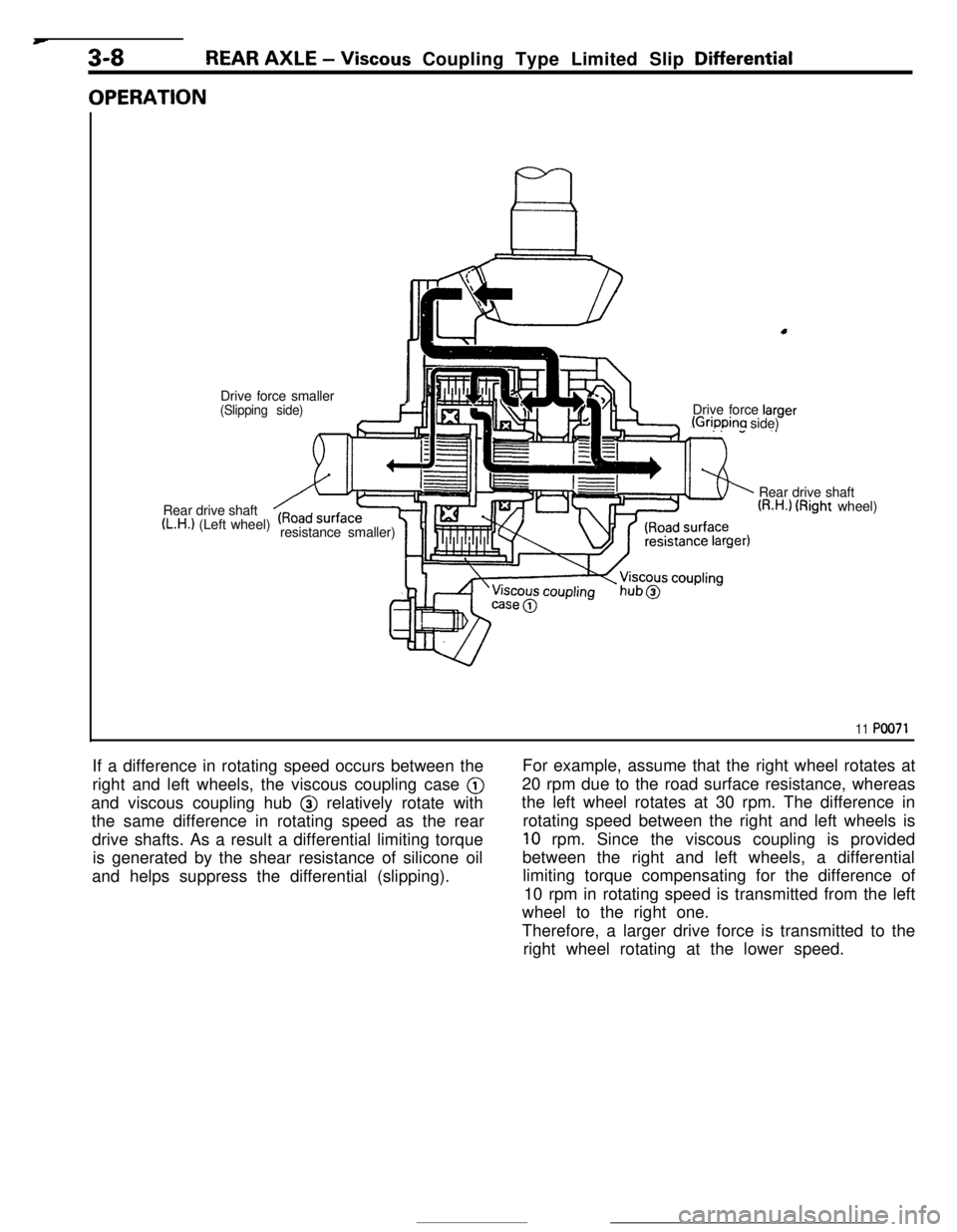
w
3-8REAR AXLE - Viscous Coupling Type Limited Slip Differential
OPERATIONDrive force smaller
I(Slipping side)Drive force larger(Grippina side)
Rear drive shaft
(L.H.1 (Left wheel)
resistance smaller)Rear drive shaft
(R.H.1 (Right wheel)
11 PO071If a difference in rotating speed occurs between the
right and left wheels, the viscous coupling case @
and viscous coupling hub @ relatively rotate with
the same difference in rotating speed as the rear
drive shafts. As a result a differential limiting torque
is generated by the shear resistance of silicone oil
and helps suppress the differential (slipping).For example, assume that the right wheel rotates at
20 rpm due to the road surface resistance, whereas
the left wheel rotates at 30 rpm. The difference in
rotating speed between the right and left wheels is
10 rpm. Since the viscous coupling is provided
between the right and left wheels, a differential
limiting torque compensating for the difference of
10 rpm in rotating speed is transmitted from the left
wheel to the right one.
Therefore, a larger drive force is transmitted to the
right wheel rotating at the lower speed.
Page 40 of 391
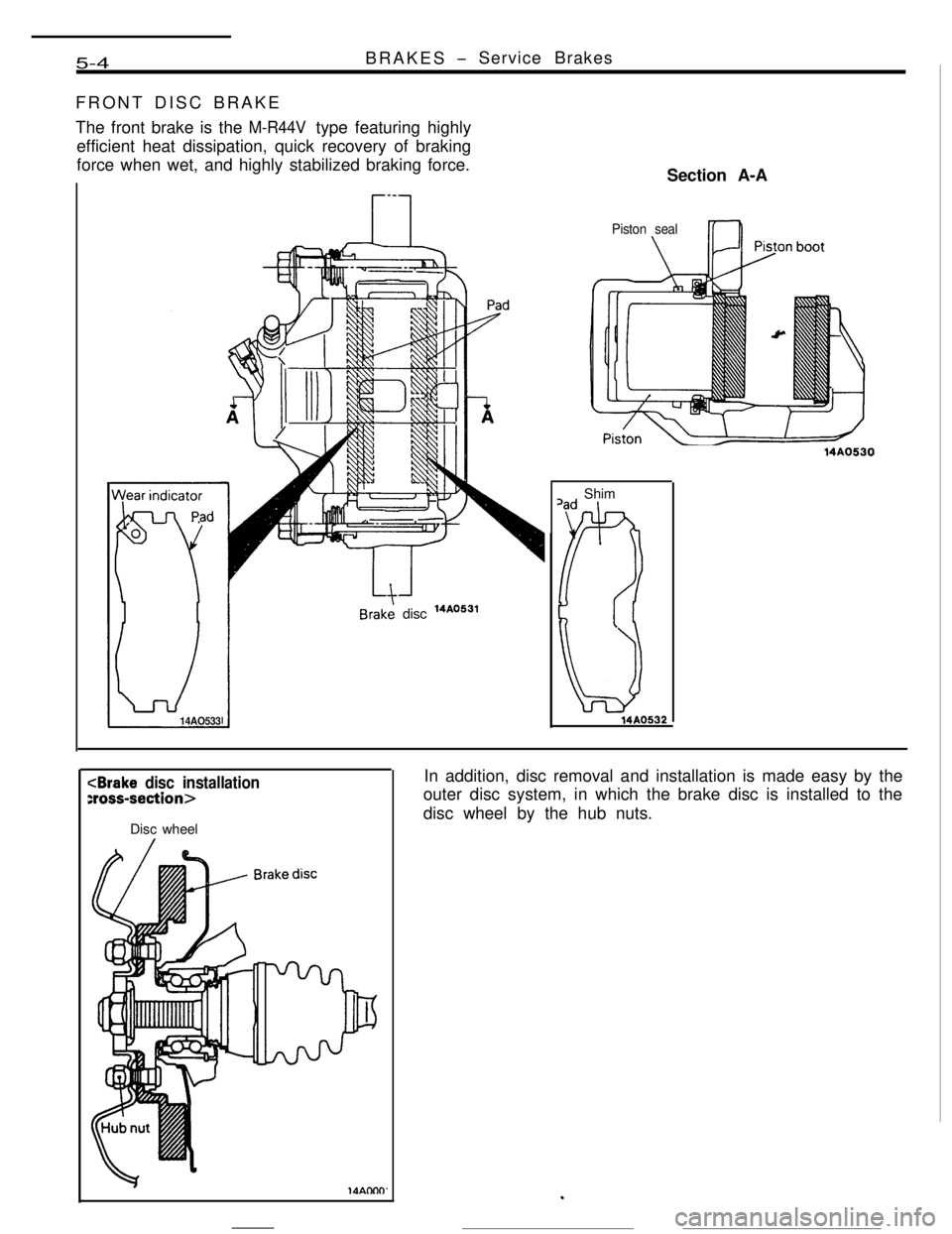
5-4
Braki disc 14A0531
Section A-A
14AO530
,ad Shim
014A0532
Disc wheel
.
Page 42 of 391
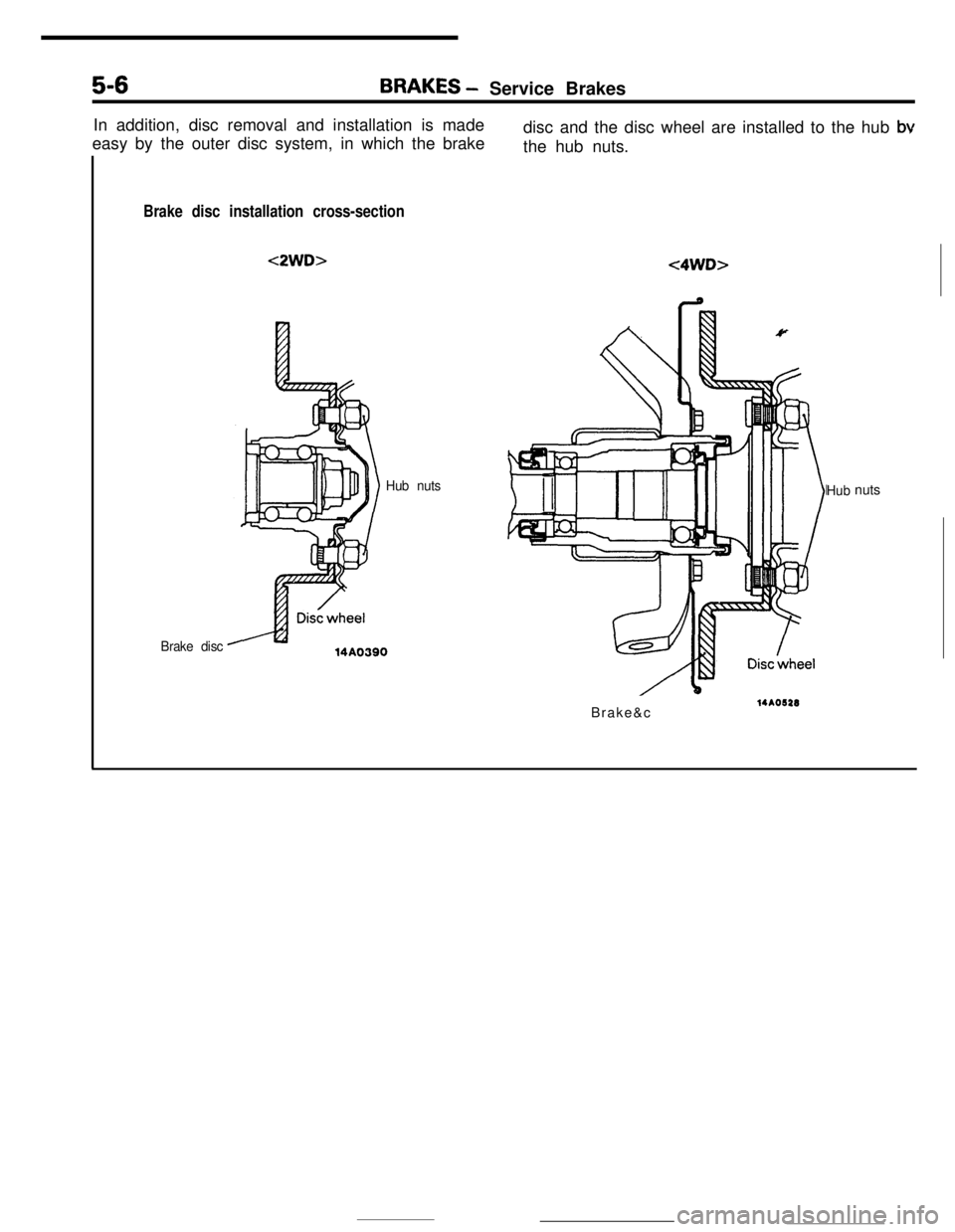
5-6BRAKES - Service Brakes
In addition, disc removal and installation is made
easy by the outer disc system, in which the brakedisc and the disc wheel are installed to the hub
bvthe hub nuts.
Brake disc installation cross-section<2WD>
<4WD>
Hub nuts
Brake disc14AO390Hubnuts
Brake&c
14AO622
Page 43 of 391
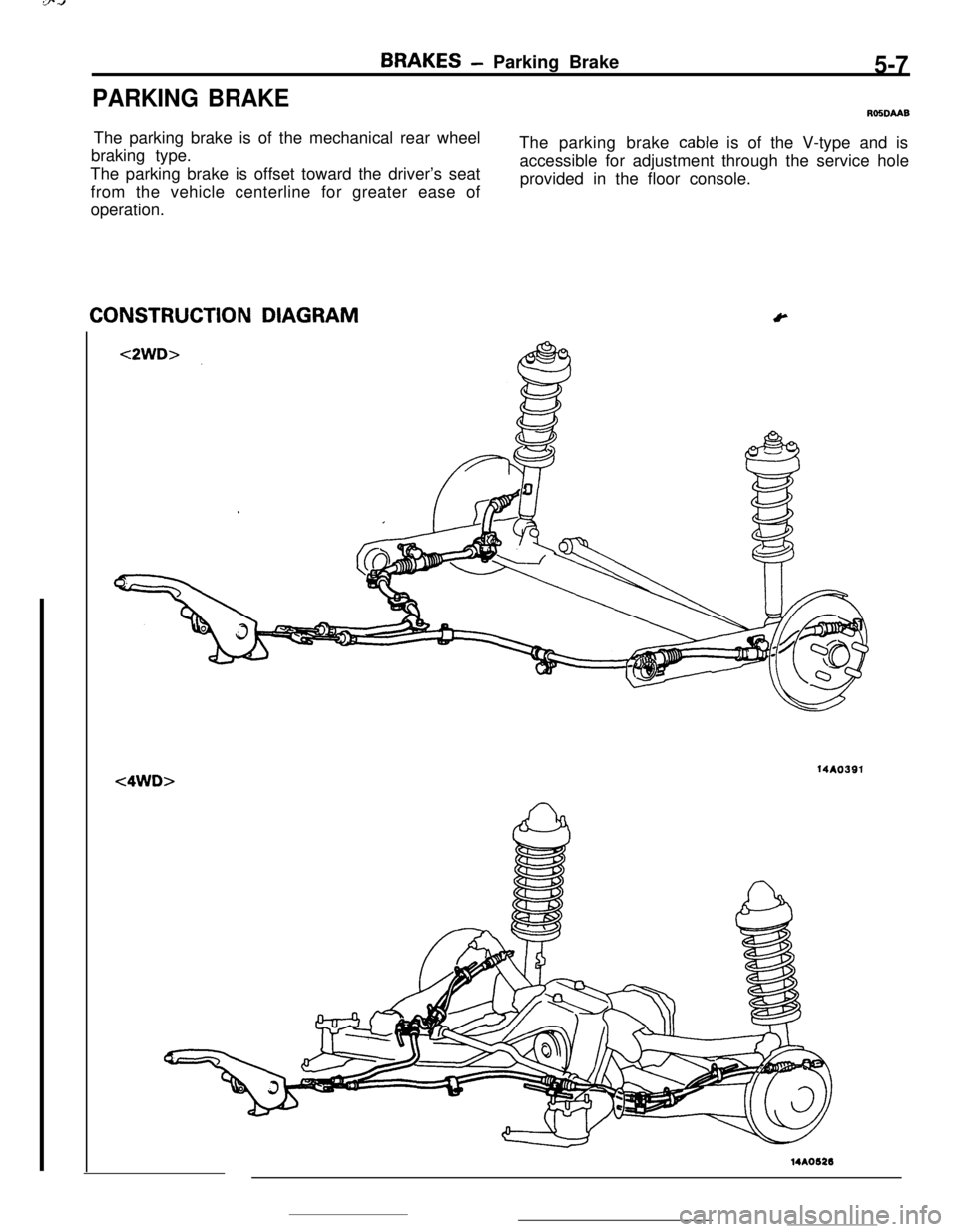
PARKING BRAKE
BRAKES- Parking Brake5-7
ROSDMBThe parking brake is of the mechanical rear wheel
braking type.The parking brake
cable is of the V-type and is
The parking brake is offset toward the driver’s seataccessible for adjustment through the service hole
provided in the floor console.
from the vehicle centerline for greater ease of
operation.CONSTRUCTION DIAGRAM
Y14AO391
<4WD>14A0626
Page 136 of 391
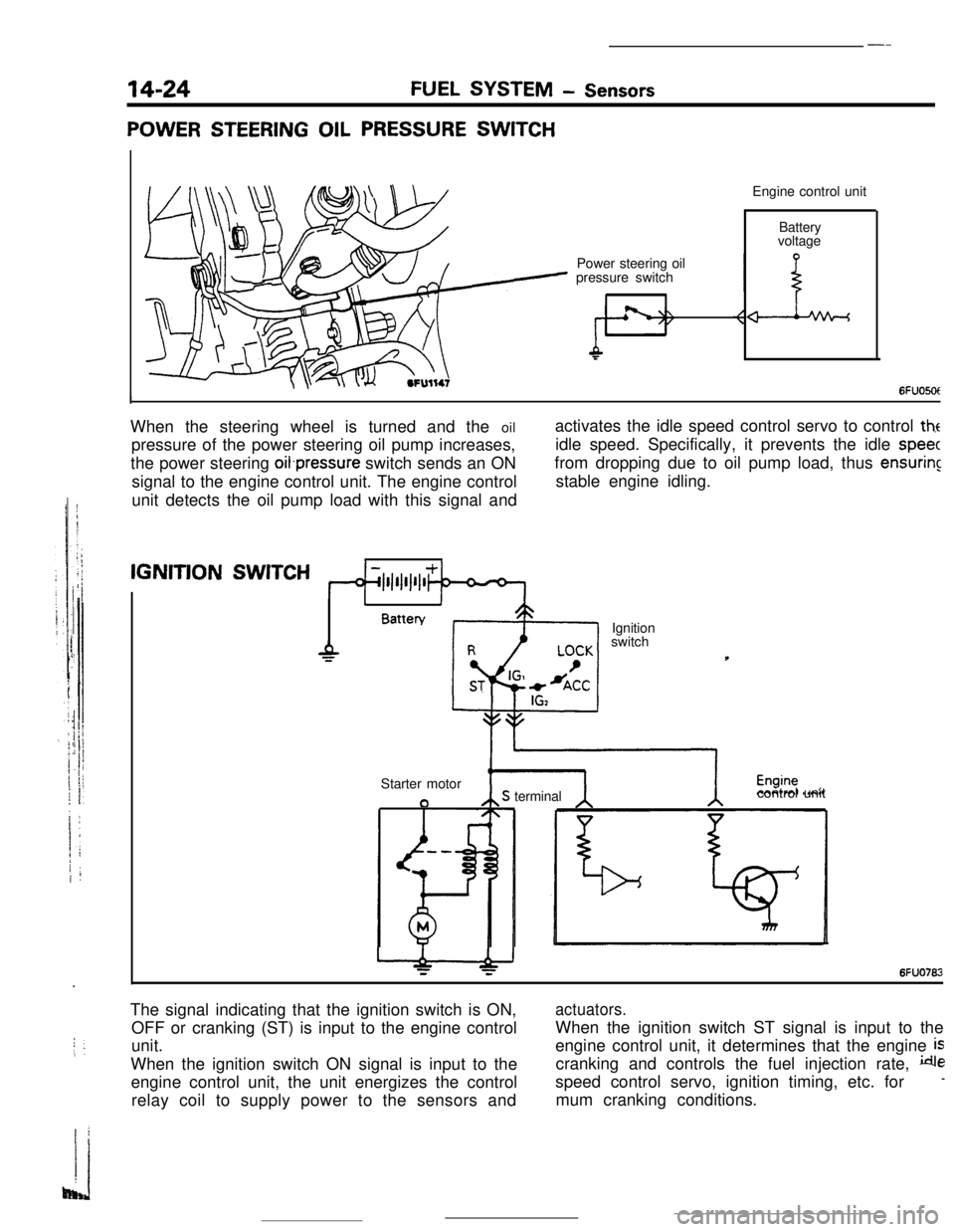
--
,
14-24FUEL SYSTEM - Sensors
POWER STEERING OIL PRESSURE SWITCHEngine control unit
Power steering oil
pressure switchBattery
voltage
6FUO5OtIWhen the steering wheel is turned and the oil
pressure of the power steering oil pump increases,
the power steering oifpressure switch sends an ON
signal to the engine control unit. The engine control
unit detects the oil pump load with this signal andactivates the idle speed control servo to control
theidle speed. Specifically, it prevents the idle
speecfrom dropping due to oil pump load, thus
ensuringstable engine idling.IGNITION
SWITCH
1IBattery
Ignition
switch
Starter motor
aS terminalcontrol unit
6FUO762The signal indicating that the ignition switch is ON,
OFF or cranking (ST) is input to the engine control
unit.
When the ignition switch ON signal is input to the
engine control unit, the unit energizes the control
relay coil to supply power to the sensors and
actuators.When the ignition switch ST signal is input to the
engine control unit, it determines that the engine
iscranking and controls the fuel injection rate,
despeed control servo, ignition timing, etc. for
-mum cranking conditions.
Page 162 of 391
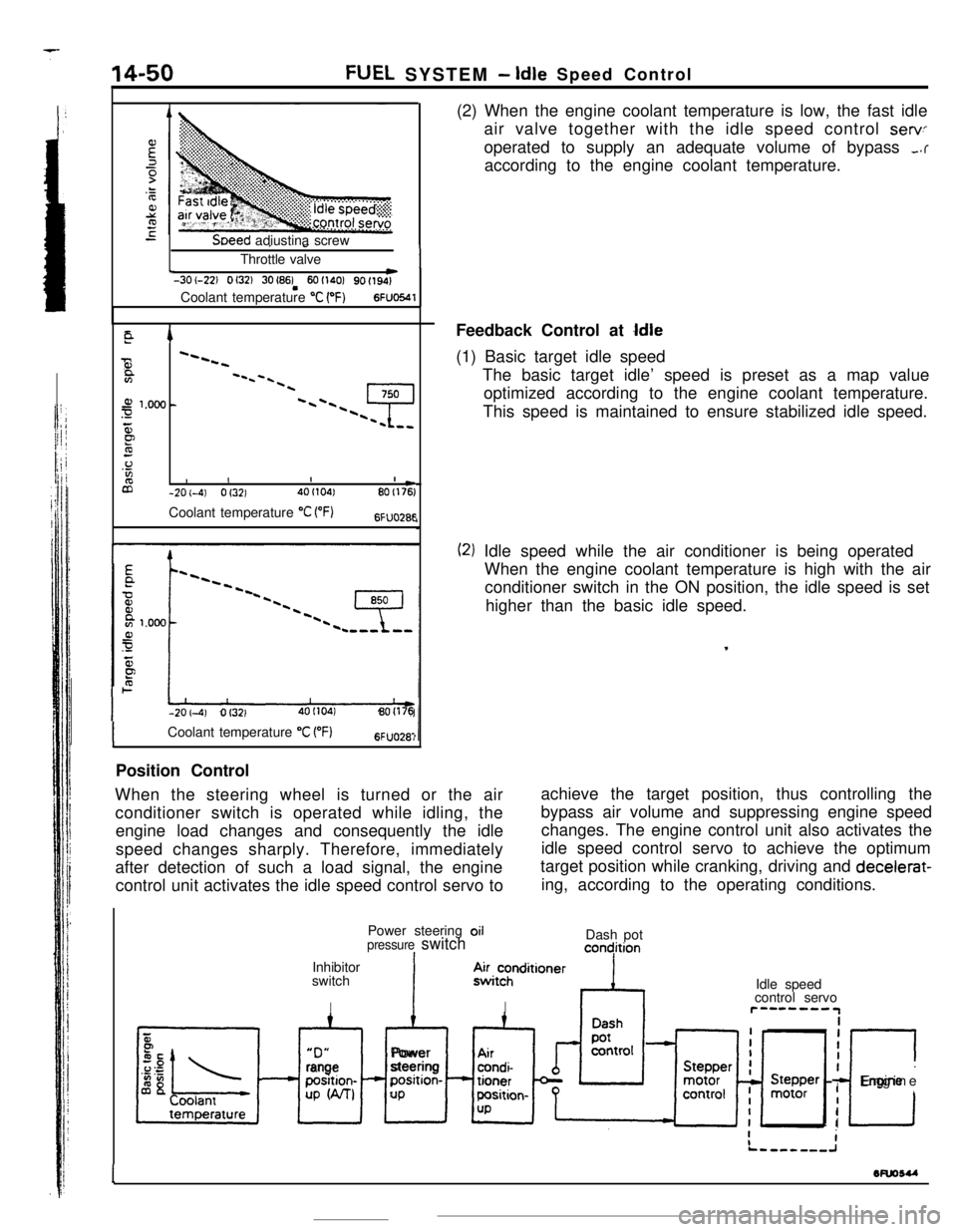
14-50FUEL SYSTEM- Idle Speed Control
SDeed adiustina screwI -Throttle valve
Lw-3O(-22) 0132) 30(86! 601140) 9ofl94)Coolant temperature
“C (OF)6FUO641
E94
72--2--I
Q--.-.-z
3201.000 --4-\-\
5P9.o%IIIaI L-2O(-41 Of3214Of104)801176)Coolant temperature
“C VF)6FU028E
-201-4) Of3214OI104180(176(2) When the engine coolant temperature is low, the fast idle
air valve together with the idle speed control
servoperated to supply an adequate volume of bypass
,.raccording to the engine coolant temperature.
Feedback Control at
Idle(1) Basic target idle speed
The basic target idle’ speed is preset as a map value
optimized according to the engine coolant temperature.
This speed is maintained to ensure stabilized idle speed.
(2) Idle speed while the air conditioner is being operated
When the engine coolant temperature is high with the air
conditioner switch in the ON position, the idle speed is set
higher than the basic idle speed.
,
ICoolant temperature “C VF)6FUO28:Position Control
When the steering wheel is turned or the air
conditioner switch is operated while idling, theachieve the target position, thus controlling the
engine load changes and consequently the idlebypass air volume and suppressing engine speed
changes. The engine control unit also activates the
speed changes sharply. Therefore, immediately
after detection of such a load signal, the engine
control unit activates the idle speed control servo toidle speed control servo to achieve the optimum
target position while cranking, driving and decelerat-
ing, according to the operating conditions.
Power steering oil
pressure switchIInhibitor
switch
IDash pot
concjition“D”
xl
rangeposition-
UP W-U
IAlPower
steeringposition-
UP.4~i~hnditioner
IIdle speed
control servor”--““IiiI
I
c
IEngine
I
I
1wuosu
-
Page 163 of 391
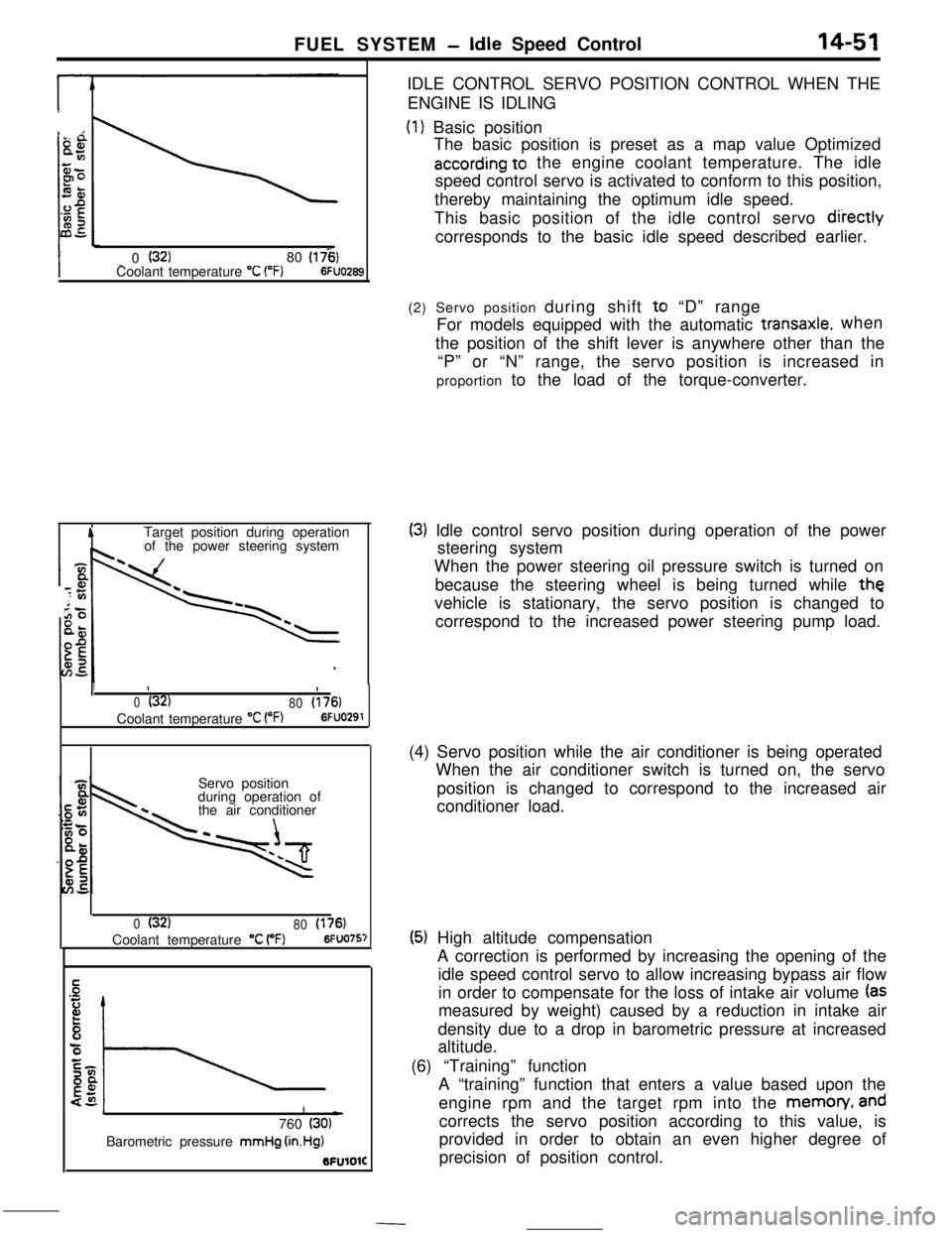
FUEL SYSTEM -Idle Speed Control14-51
_ 0 (32)80 (175)Coolant temperature “C (“F)6FUO2653
ATarget position during operation
of the power steering systemIDLE CONTROL SERVO POSITION CONTROL WHEN THE
ENGINE IS IDLING
(1) Basic position
The basic position is preset as a map value Optimized
according to the engine coolant temperature. The idle
speed control servo is activated to conform to this position,
thereby maintaining the optimum idle speed.
This basic position of the idle control servo
diiectlycorresponds to the basic idle speed described earlier.
1II
0(32)
80(176)Coolant temperature
“C VW6FUO291Servo position
during operation of
the air conditioner
0(32)
80(176)Coolant temperature “C (“F)6FUO757
1L)760 (30)Barometric pressure mmHg
(in.Hg)BFUlOlC(2) Servo position during shift to “D” range
For models equipped with the automatic
transaxle.when
the position of the shift lever is anywhere other than the
“P” or “N” range, the servo position is increased in
proportion to the load of the torque-converter.
(3) Idle control servo position during operation of the power
steering system
When the power steering oil pressure switch is turned on
because the steering wheel is being turned while
thevehicle is stationary, the servo position is changed to
correspond to the increased power steering pump load.
(4) Servo position while the air conditioner is being operated
When the air conditioner switch is turned on, the servo
position is changed to correspond to the increased air
conditioner load.
(5) High altitude compensation
A correction is performed by increasing the opening of the
idle speed control servo to allow increasing bypass air flow
in order to compensate for the loss of intake air volume
(asmeasured by weight) caused by a reduction in intake air
density due to a drop in barometric pressure at increased
altitude.
(6) “Training” function
A “training” function that enters a value based upon the
engine rpm and the target rpm into the memon/,
andcorrects the servo position according to this value, is
provided in order to obtain an even higher degree of
precision of position control.
Page 183 of 391
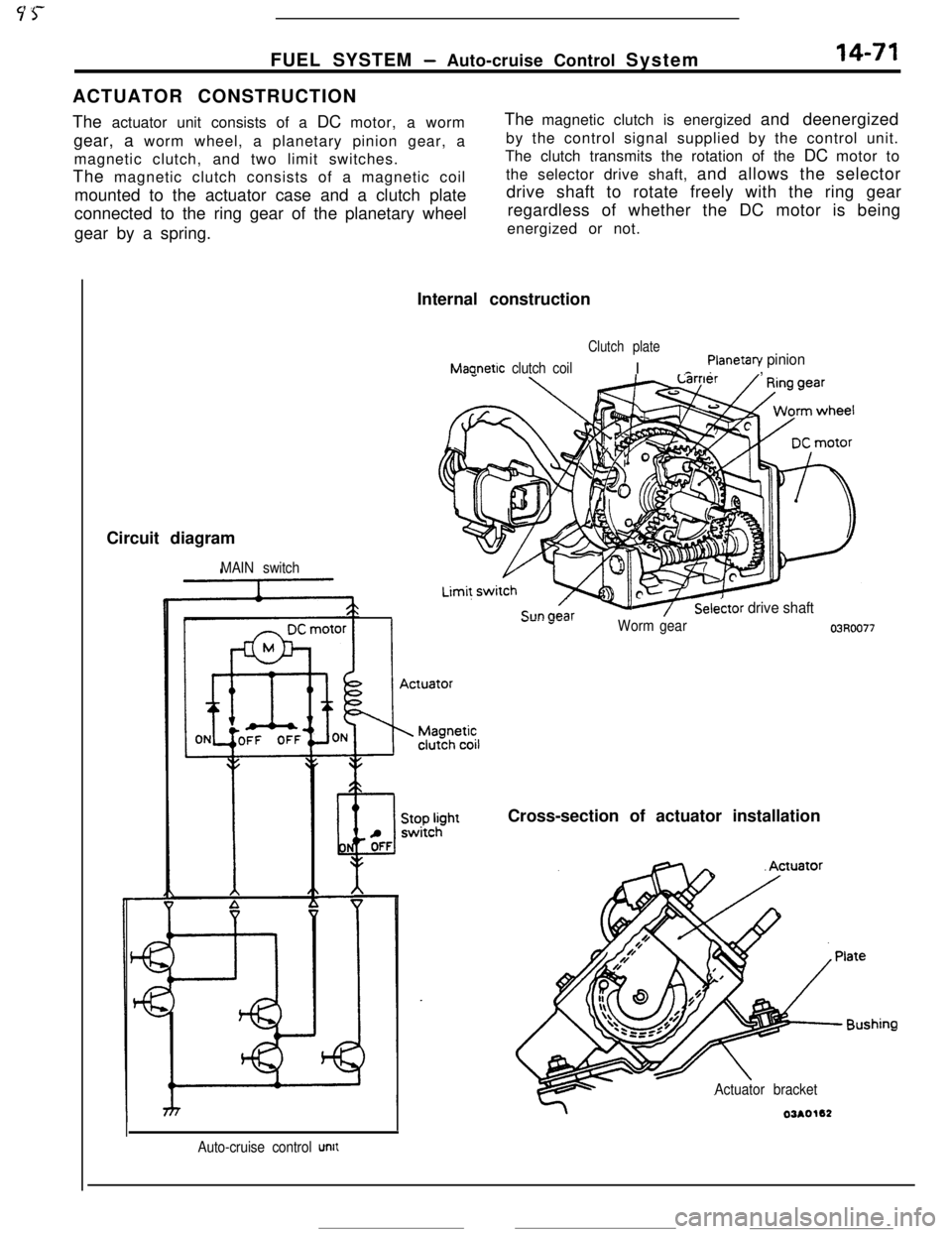
Y 5-FUEL SYSTEM
- Auto-cruise Control System14-71ACTUATOR CONSTRUCTION
The actuator unit consists of a DC motor, a worm
gear, a worm wheel, a planetary pinion gear, a
magnetic clutch, and two limit switches.
The magnetic clutch consists of a magnetic coil
mounted to the actuator case and a clutch plate
connected to the ring gear of the planetary wheel
gear by a spring.The magnetic clutch is energized and deenergized
by the control signal supplied by the control unit.
The clutch transmits the rotation of the DC motor to
the selector drive shaft, and allows the selector
drive shaft to rotate freely with the ring gear
regardless of whether the DC motor is being
energized or not.
Internal construction
Clutch plate
Maanetic clutch coilI ^. ,Planetan/ pinionCircuit diagram
MAIN switch
%tn m.=ir
Auto-cruise control unit
7S&&or drive shaft
Worm gear03R0077
Cross-section of actuator installation
Actuator bracket
Page 184 of 391
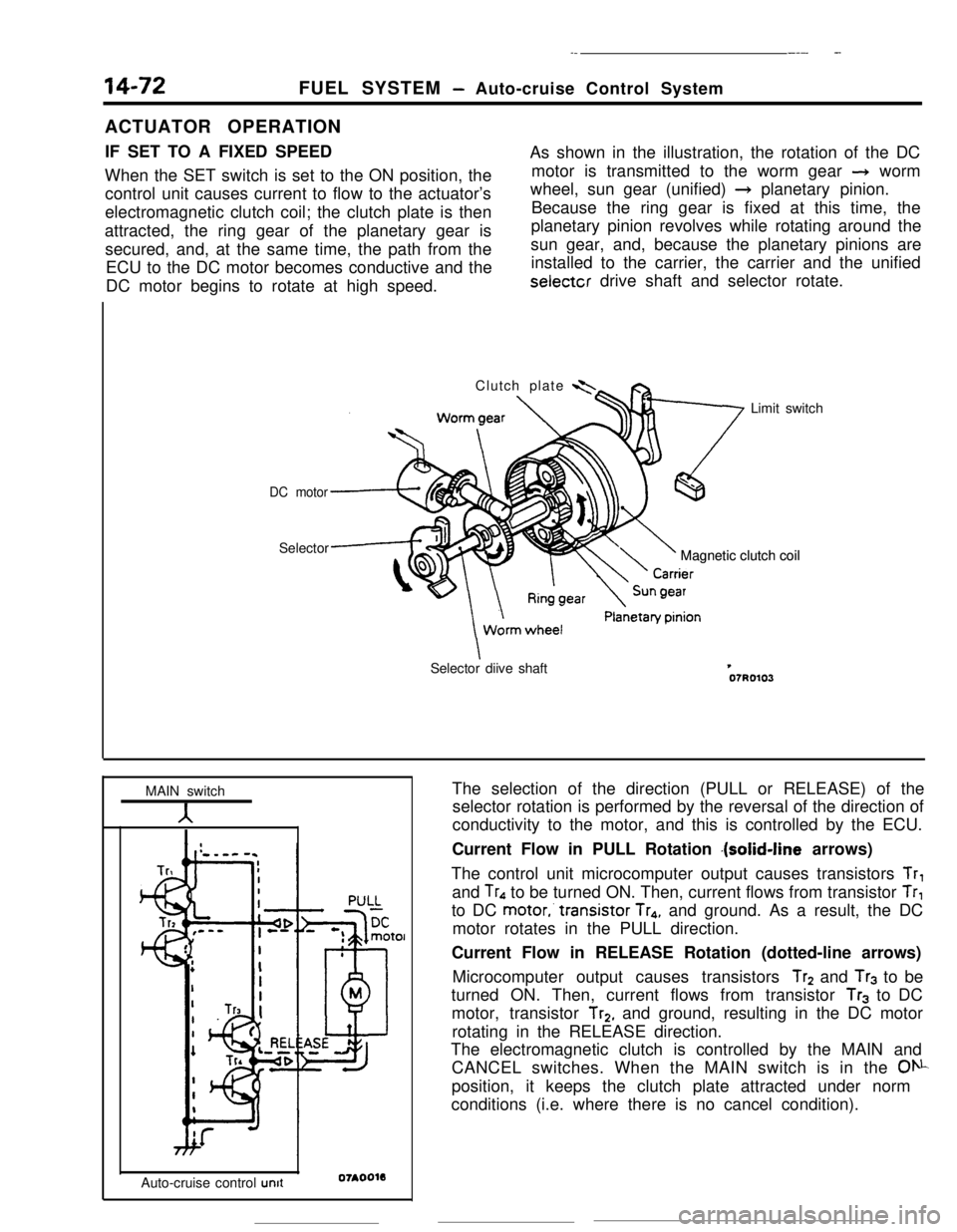
14-72
._FUEL SYSTEM
- Auto-cruise Control System
___ -ACTUATOR OPERATION
IF SET TO A FIXED SPEED
When the SET switch is set to the ON position, the
control unit causes current to flow to the actuator’s
electromagnetic clutch coil; the clutch plate is then
attracted, the ring gear of the planetary gear is
secured, and, at the same time, the path from the
ECU to the DC motor becomes conductive and the
DC motor begins to rotate at high speed.As shown in the illustration, the rotation of the DC
motor is transmitted to the worm gear
--, worm
wheel, sun gear (unified)
+ planetary pinion.
Because the ring gear is fixed at this time, the
planetary pinion revolves while rotating around the
sun gear, and, because the planetary pinions are
installed to the carrier, the carrier and the unifiedselectcr drive shaft and selector rotate.
Clutch plate
<
7 Limit switch
DC motorSelector
Magnetic clutch coil Magnetic clutch coil
Selector diive shaft
MAIN switchTrl
4sTn
aAuto-cruise control
unit07AOO11The selection of the direction (PULL or RELEASE) of the
selector rotation is performed by the reversal of the direction of
conductivity to the motor, and this is controlled by the ECU.
Current Flow in PULL Rotation
.(soiid-line arrows)
The control unit microcomputer output causes transistors
Tr,and Tr, to be turned ON. Then, current flows from transistor
Tr,to DC motor,‘transistor
Tr,, and ground. As a result, the DC
motor rotates in the PULL direction.
Current Flow in RELEASE Rotation (dotted-line arrows)
Microcomputer output causes transistors
Tr2 and Tr3 to be
turned ON. Then, current flows from transistor
Tr3 to DC
motor, transistor
Tr2, and ground, resulting in the DC motor
rotating in the RELEASE direction.
The electromagnetic clutch is controlled by the MAIN and
CANCEL switches. When the MAIN switch is in the
01\L.position, it keeps the clutch plate attracted under norm
conditions (i.e. where there is no cancel condition).
Page 197 of 391
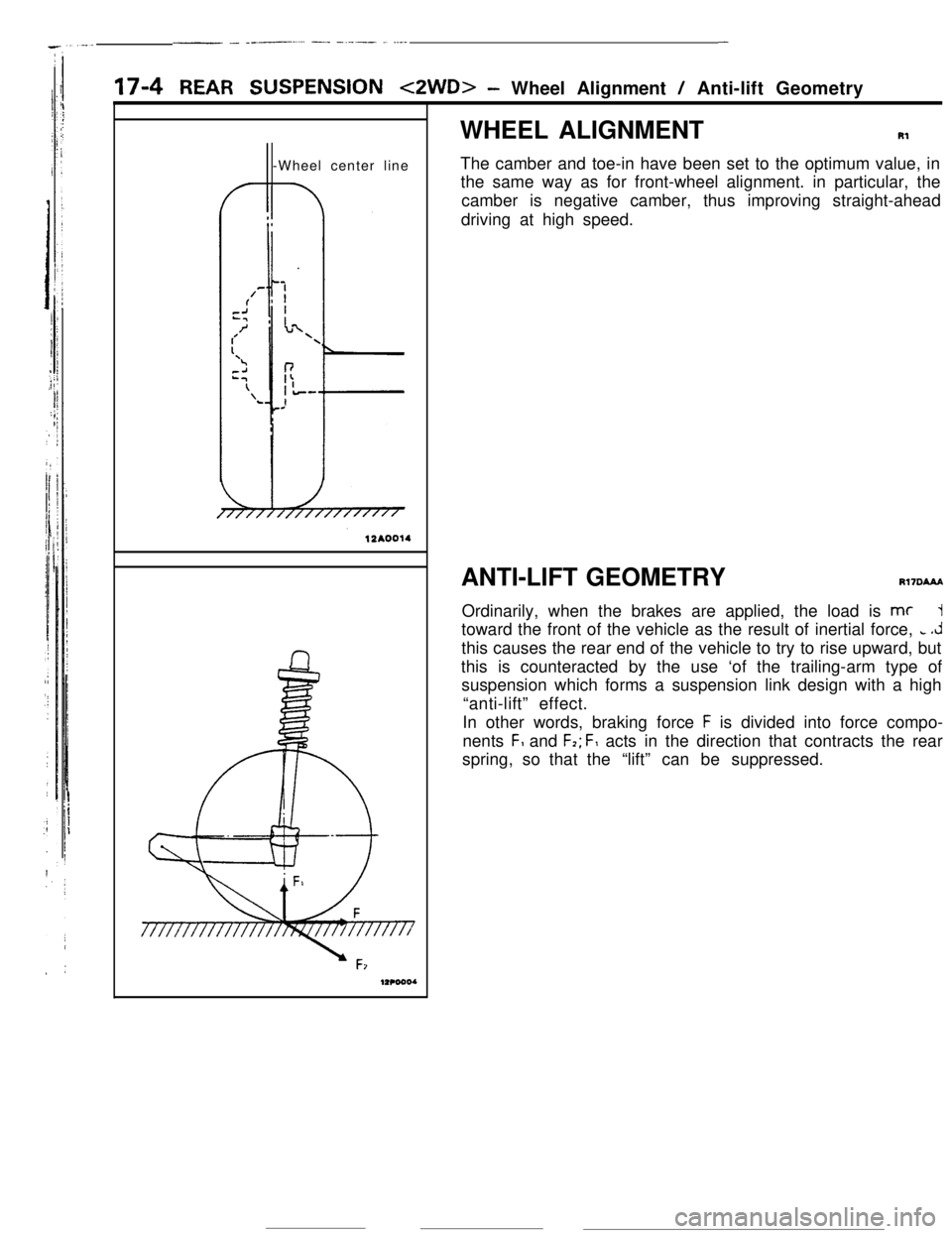
- ._ ____.-.-- -.._ -.-.- - ..__-
17-4 REAR SUSPENSION tZWD>- Wheel Alignment / Anti-lift Geometry
-Wheel center lineWHEEL ALIGNMENTRl
The camber and toe-in have been set to the optimum value, in
the same way as for front-wheel alignment. in particular, the
camber is negative camber, thus improving straight-ahead
driving at high speed.
ANTI-LIFT GEOMETRY
Rl7DAAAOrdinarily, when the brakes are applied, the load is
mc1toward the front of the vehicle as the result of inertial force,
c .Jthis causes the rear end of the vehicle to try to rise upward, but
this is counteracted by the use ‘of the trailing-arm type of
suspension which forms a suspension link design with a high
“anti-lift” effect.
In other words, braking force
F is divided into force compo-
nents
F, and F,; F, acts in the direction that contracts the rear
spring, so that the“lift” can be suppressed.